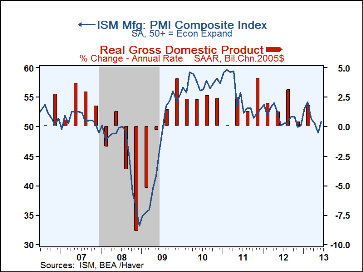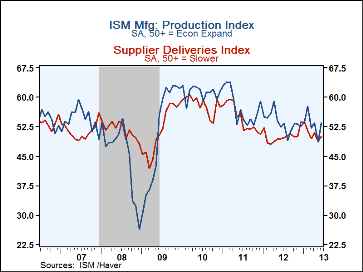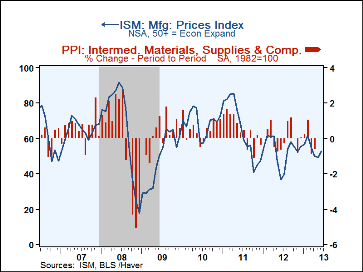 Global| Jul 01 2013
Global| Jul 01 2013U.S. ISM Composite Factory Sector Index Recovers
by:Tom Moeller
|in:Economy in Brief
Summary
The Composite Index of manufacturing sector activity from the Institute for Supply Management improved to 50.9 during June versus an unrevised 49.0 in May. The figure roughly matched consensus expectations for 50.5. Any figure above [...]
The Composite Index of manufacturing sector activity from the Institute for Supply Management improved to 50.9 during June versus an unrevised 49.0 in May. The figure roughly matched consensus expectations for 50.5. Any figure above 50 indicates an increasing level of activity. During the last ten years, there has been a 69% correlation between the ISM index and the q/q change in real GDP.
Leading the rebound in the overall index was a higher production reading. It rose to 53.4 but remained below the February high of 57.6. Also rising was the new orders figure to 51.9 but that also remained lower than the February high of 57.8. The separate index of new export orders also rebounded to 54.5. The inventories index improved to 50.5, suggesting a modest rate of inventory building. The supplier delivery index ticked up to 50.0, thus indicating slower delivery speeds. The number remained, however, sharply lower versus December's high of 53.7. A lower level of factory sector employment was indicated by the employment reading which fell to 48.7. That was nearly the lowest level of the economic recovery. During the last ten years there has been an 88% correlation between the employment index and the m/m change in factory payrolls.
The prices paid index recovered slightly to 52.5. Twenty percent of firms raised prices while fifteen percent lowered them. During the last ten years there has been a 65% correlation between the index and the m/m change in the intermediate producer price index.
The figures from the Institute For Supply Management (ISM) are diffusion indexes and can be found in Haver's USECON database. The expectations data are in the AS1REPNA database.
| ISM Mfg | Jun | May | Apr | Jun'12 | 2012 | 2011 | 2010 |
|---|---|---|---|---|---|---|---|
| Composite Index | 50.9 | 49.0 | 50.7 | 50.2 | 51.7 | 55.2 | 57.3 |
| New Orders | 51.9 | 48.8 | 52.3 | 49.6 | 52.9 | 56.4 | 59.2 |
| Production | 53.4 | 48.6 | 53.5 | 52.4 | 53.6 | 57.4 | 61.0 |
| Employment | 48.7 | 50.1 | 50.2 | 55.7 | 53.8 | 57.4 | 57.3 |
| Supplier Deliveries | 50.0 | 48.7 | 50.9 | 49.5 | 50.0 | 54.7 | 58.1 |
| Inventories | 50.5 | 49.0 | 46.5 | 44.0 | 48.2 | 50.1 | 50.8 |
| Prices Paid Index (NSA) | 52.5 | 49.5 | 50.0 | 37.0 | 53.2 | 65.2 | 68.9 |
Tom Moeller
AuthorMore in Author Profile »Prior to joining Haver Analytics in 2000, Mr. Moeller worked as the Economist at Chancellor Capital Management from 1985 to 1999. There, he developed comprehensive economic forecasts and interpreted economic data for equity and fixed income portfolio managers. Also at Chancellor, Mr. Moeller worked as an equity analyst and was responsible for researching and rating companies in the economically sensitive automobile and housing industries for investment in Chancellor’s equity portfolio. Prior to joining Chancellor, Mr. Moeller was an Economist at Citibank from 1979 to 1984. He also analyzed pricing behavior in the metals industry for the Council on Wage and Price Stability in Washington, D.C. In 1999, Mr. Moeller received the award for most accurate forecast from the Forecasters' Club of New York. From 1990 to 1992 he was President of the New York Association for Business Economists. Mr. Moeller earned an M.B.A. in Finance from Fordham University, where he graduated in 1987. He holds a Bachelor of Arts in Economics from George Washington University.










